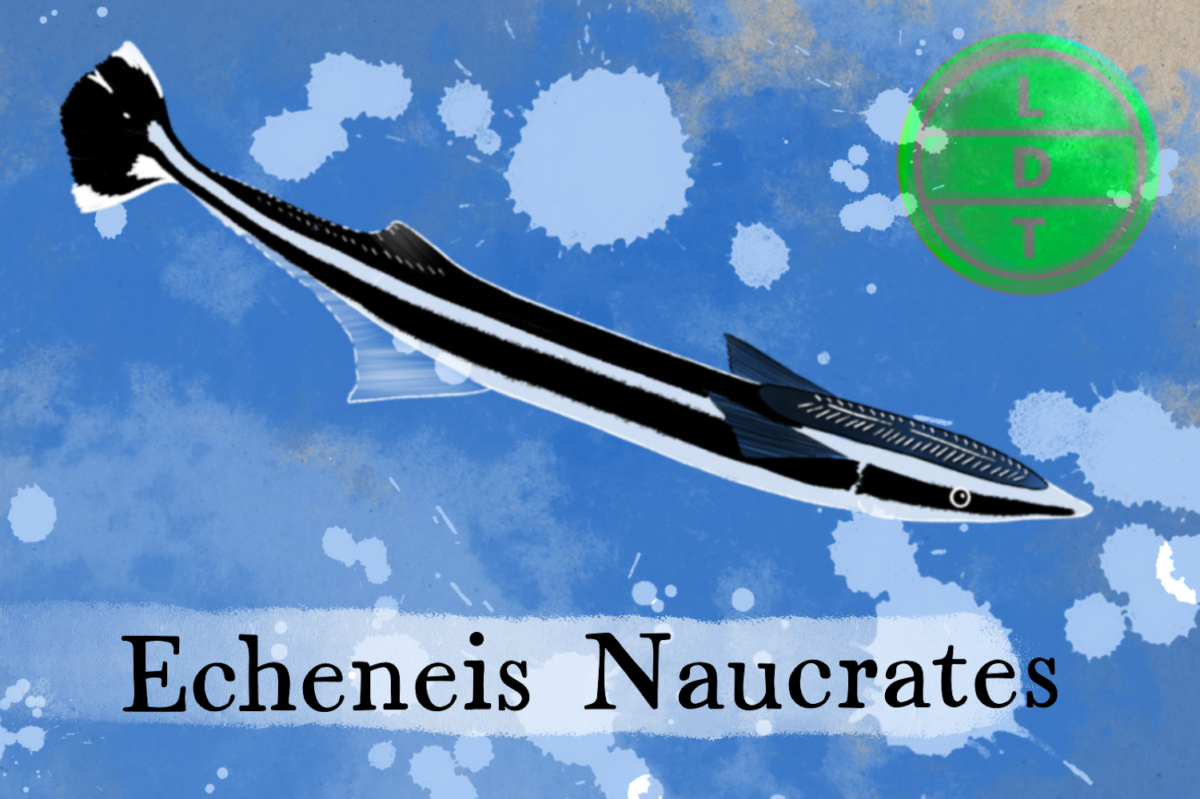“…and today we’re talking about a sucker who will latch onto anything and go with it. But more on that later.”
If you see a shark, whale, or large fish gliding through the open ocean, you may see some extra passengers stuck to its flanks. The live sharksucker is a remora, a fish that freeloads off of other, bigger animals. But why grab an oceanic uber when your fins work just fine? Well, grab your towel because you gotta abide by the hitchhiker’s guide to the ocean to survive here in Life, Death, and Taxonomy.
Description of the Live Sharksucker
Its body is elongated and streamlined. It has a stark underbite, with a lower jaw that projects forward beyond the upper jaw.
The jaws, vomer, and tongue have villiform teeth.
The most recognizable feature is the oval-shaped suction disc, which is an adapted dorsal that is fin positioned from the top of the head to the anterior part of the body.
The body background coloration is dark gray to dark brown, with a dark belly. A dark stripe runs along the body’s axis, with a whitish margin. The caudal fin is black with white corners.
Measure Up
Welcome to the beloved Measure Up segment. The official listener’s favorite part of the show! The part of the show when we present the animal’s size and dimension in relatable terms through a quiz that’s fun for the whole family. It’s also the part of the show that’s introduced by you when you send in audio of yourself saying, singing, or chittering the words Measure Up into ldtaxonomy at gmail dot com. We do have a new Measure Up intro!
Length: 110 centimeters (43 inches)
- How many remoras go into the length of the longest broom?
- Hint: The longest broom was made in the Netherlands in 2006 by members of Kreateam 2006. I looked that up and I have no idea what it is.
- 29.88 remoras. The largest broom was 32.65 m (107 ft 1 in).
Weight: Five pounds
- How many live sharksuckers go into the largest sucker, aka lollipop?
- Hint: See’s Candies created the big candy in the United States at the See’s Candies Lollypop Factory in Burlingame, California, on July 18, 2012. The stick is 11 feet 10 inches tall.
- 1,400.6 sharksuckers. The lollipop was 3176.5 kilograms (7,003 pounds)
Fast Facts about the Live Sharksucker
Habitat: They are found in warm seas around the world in the Western Atlantic, ranging from Nova Scotia, Canada, through Bermuda and the Gulf of Mexico, down to Uruguay, and in the Mediterranean Sea.
They Like shallow inshore brackish areas and around coral reefs. They inhabit depths ranging from 20 to 50 meters (approximately 66 to 160 feet), which corresponds to the location of coral reefs.
Sightings of E. naucrates have also occurred near Long Island, New Jersey, Massachusetts, and even traveling up the Hudson River while attached to a host.
Diet: Aremora’s diet varies based on its maturity and situation:
- As a juvenile, it acts as a cleaner fish on reef stations, feeding on small parasitic crustaceans such as copepods, isopods, and ostracods.
- It consumes crustaceans, squid, and small fish parasitic crustaceans and small food captured by filtering water through its villiform teeth.
Major Fact: Flow Ride
- Remoras have a unique feature on their heads that lets them take easy street
- Their dorsal fins are different from those of any other fish
- These fins don’t look like fins at all. They look more like a carved out avocado half
- A sort of shallow bowl with ribbed sides
- These ribs can be raised or lowered to open and close the spaces between the ribs and a surface to generate suction
- So the remora has a reverse plunger stuck to its forehead, but why?
- Well the remora has a unique respiratory system – at least when it comes to fish
- Fish, in general, need to have water flow over their gills in order to extract oxygen and fuel their respiratory system
- Some fish have active ventilation where they pump their gills in and out constantly to move water over their gills
- Others, like most sharks, have what’s called ram ventilation, which requires them to move their whole bodies forward in order to have water flow over their gills
- The remora can do both, but both require energy… unless you know how to swim smarter and not harder
- By using its face plunger to attach itself to something that’s moving, it can just hitch a ride and switch to ram ventilation without all the hassle of actually swimming. It can latch to sharks, whales, large fish, rays, turtles, dugongs, dolphins, boats, and even divers.
- This is a form of commensalism called phoresy. Or animals just hitching a ride on other animals.
- So the breathing problem is solved, and it doesn’t even hurt the sucker giving the ride (outside of increasing drag). But then how does it eat if its stuck to a whale all day?
- The answer is that it eats some of the dead skin, barnacles, crustaceans, and other nuisances the host might be dealing with, so the deal is mutualistic to a degree. But it mainly feeds on the animal’s excrement. How does it do that when its cruising along? No idea. Maybe it darts out to grab a quick bite after a solid BM and then latches back on.
- Doesn’t exactly work for boats though
- Researchers initially thought it would eat the scraps from the host’s prey, but recent studies show that’s not the case.
Ending: So take the easy route through life, find an oceanic ride, and glue your head to the nearest shark so you can breathe and also eat its feces like the sharksucker here in LDT.

